 W
WThe history of Wales begins with the arrival of human beings in the region thousands of years ago. Neanderthals lived in what is now Wales, or Cymru in the Welsh language, at least 230,000 years ago, while Homo sapiens arrived by about 31,000 BC. However, continuous habitation by modern humans dates from the period after the end of the last ice age around 9000 BC, and Wales has many remains from the Mesolithic, Neolithic, and Bronze Age. During the Iron Age the region, like all of Britain south of the Firth of Forth, was dominated by the Celtic Britons and the Brittonic language. The Romans, who began their conquest of Britain in AD 43, first campaigned in what is now northeast Wales in 48 against the Deceangli, and gained total control of the region with their defeat of the Ordovices in 79. The Romans departed from Britain in the 5th century, opening the door for the Anglo-Saxon invasion. Thereafter Brittonic language and culture began to splinter, and several distinct groups formed. The Welsh people were the largest of these groups, and are generally discussed independently of the other surviving Brittonic-speaking peoples after the 11th century.
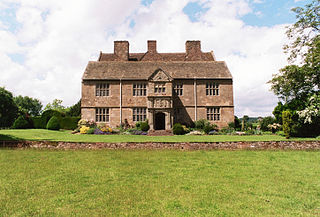 W
WPeter Smith (1926–2013) was an architectural historian. His most important work, Houses of the Welsh Countryside, has been described as having "a defining influence on the understanding, enjoyment and conservation of Welsh traditional architecture".
 W
WThis is a timeline of Welsh history, comprising important legal and territorial changes, and political events in Wales.
 W
WThe history of Wales in the Roman era began in 48 AD with a military invasion by the imperial governor of Roman Britain. The conquest would be completed by 78, and Roman rule would endure until the region was abandoned in AD 383.
 W
WArchaeologia Cambrensis is a Welsh archaeological and historical scholarly journal published annually by the Cambrian Archaeological Association. It contains historical essays, excavation reports, and book reviews, as well as society notes and accounts of field visits. The journal has included "much valuable material on the manuscripts, genealogy, heraldry, toponymy, folklore and literature of Wales".
 W
WIn Celtic cultures, a bard was a professional story teller, verse-maker, music composer, oral historian and genealogist, employed by a patron to commemorate one or more of the patron's ancestors and to praise the patron's own activities.
 W
WBaron of Cymmer-yn-Edeirnion, in the county of Merioneth, is a dormant title used by the senior male-line descendants of Owain Brogyntyn, youngest son of Madog ap Maredudd king of Powys. Owain Brogyntyn divided his lands equally between his three sons on his death, and his eldest son, Iorwerth, inherited lands centred on Cymmer, in the parish of Llangar and commote of Edeirnion. His son, Gruffydd ab Iorwerth, fought against Edward I during his invasion of Wales. After the Conquest of Wales, Gruffydd came "into the King's peace", and on 22 July 1284, had his lands confirmed by Edward I per baroniam, 'just as his ancestors had held them', thereby creating him a baron in the English feudal baronage. The first surviving use of the title was by Gruffydd's grandson, Owain, who in 1334 was summoned to the sessions at Harlech as Owenus ap Davidus, Dominus de Kimmer. Some authorities, therefore, date the barons from Owain, whereas others begin with Gruffydd. In the fifteenth century their principal residence was known as Plas o Cymmer, and was later renamed Plas Uchaf. Later the 10th Baron moved to the nearby mansion of Gwerclas.Gruffydd ab Iorwerth ab Owain Brogyntyn, 1st Baron of Kymmer-yn-Edeirnion Dafydd ap Gruffydd, his son,, 2nd Baron of Kymmer-yn-Edeirnion Owain ap Dafydd, his son,, 3rd Baron of Kymmer-yn-Edeirnion Llywelyn Ddu ap Dafydd, his brother, 4th Baron of Kymmer-yn-Edeirnion Ieuan ap Llywelyn Ddu, his son,, 5th Baron of Kymmer-yn-Edeirnion Rhys ab Ieuan, his son,, 6th Baron of Kymmer-yn-Edeirnion, ancestor of the Jones of Faerdref Uchaf family. Dafydd ap Rhys, his son,, 7th Baron of Kymmer-yn-Edeirnion Gruffydd Fychan ap Dafydd, his son, 8th Baron of Kymmer-yn-Edeirnion William ap Gruffydd Fychan, his son, 9th Baron of Kymmer-yn-Edeirnion Huw ap William, his son,, 10th Baron of Kymmer-yn-Edeirnion, who moved his residence from Plas Uchaf to Gwerclas. His pedigree and arms were confirmed at the visitations of Wales on 7 October 1594. Humphrey Hughes, his son,, 11th Baron of Kymmer-yn-Edeirnion, who assumed, with his brother, the surname 'Hughes' and was High Sheriff of Merionethshire in 1618. Richard Hughes, his brother (1561-1641), 12th Baron of Kymmer-yn-Edeirnion, who was High Sheriff of Merionethshire in 1619. Humphrey Hughes, his son (1605-1682), 13th Baron of Kymmer-yn-Edeirnion, who was a Commissioner of Array during the English Civil War and fought at the Battle of Rowton Moor. He was High Sheriff of Merionethshire in 1661. Hugh Hughes, his grandson (1659-1725), 14th Baron of Kymmer-yn-Edeirnion, and was High Sheriff of Merionethshire in 1720. Daniel Hughes, his nephew (1694-1754), 15th Baron of Kymmer-yn-Edeirnion John Hughes, his son (1742-1784), 16th Baron of Kymmer-yn-Edeirnion William Hughes, his son (1779-1836), 17th Baron of Kymmer-yn-Edeirnion William Hughes, his son (1801-), 18th Baron of Kymmer-yn-Edeirnion, a Captain in the Royal Horse Guards. The Rev'd. William O'Farrell Hughes, his son (1838-), 19th Baron of Kymmer-yn-Edeirnion
 W
WThis is a bibliography of published works on the history of Wales. It includes published books, journals, and educational and academic history-related websites; it does not include self-published works, blogs or user-edited sites. Works may cover aspects of Welsh history inclusively or exclusively.
 W
WMonmouthshire Houses: A Study of Building Techniques and Smaller House-Plans in the Fifteenth to Seventeenth Centuries is a study of buildings within the county of Monmouthshire written by Sir Cyril Fox and Lord Raglan and published by the National Museum of Wales. The study was published in three volumes; Part I Medieval Houses, Part II Sub-Medieval Houses, c. 1550–1610 and Part III Renaissance Houses, c. 1590–1714, between 1951 and 1954. The series was republished by Merton Priory Press in 1994. A later historian of Welsh architecture has described the work as equal in importance, in its own field, to Charles Darwin's On the Origin of Species.
 W
WCambriae Typus, the "model image of Wales", is the earliest published map of Wales as a separate country from the rest of Great Britain. Made by Elizabethan polymath Humphrey Llwyd in 1573, the map shows Wales stretching to the River Severn, including large areas of what is now England.
 W
WThe Cambrian Archaeological Association was founded in 1846 to examine, preserve and illustrate the ancient monuments and remains of the history, language, manners, customs, arts and industries of Wales and the Welsh Marches and to educate the public in such matters. The association's activities include sponsoring lectures, field visits, and study tours; as well as publishing its journal, Archaeologia Cambrensis, and monographs. It also provides grants to support research and publications.
 W
WCapel Celyn was a rural community to the north west of Bala in Gwynedd, Wales, in the Afon Tryweryn valley. The village and other parts of the valley were flooded in 1965 to create a reservoir, Llyn Celyn, in order to supply Liverpool and Wirral with water for industry. Capel is Welsh for chapel, while celyn is Welsh for holly.
 W
WChirkland was a marcher lordship in north-east Wales. It was created in 1282 from parts of Powys Fadog granted to Roger Mortimer de Chirk, third son of Roger Mortimer, 1st Baron Mortimer of Wigmore, who then built Chirk Castle from where the lordship was administered.
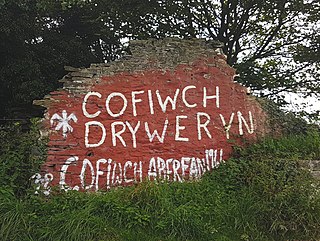 W
WCofiwch Dryweryn or Y Wal Cofiwch Dryweryn is a graffitied stone wall near Llanrhystud, Wales. Author and journalist Meic Stephens originally painted the words onto the wall of a ruined cottage in the early 1960s following the decision by the Liverpool City Council to flood the Tryweryn Valley to create the Llyn Celyn reservoir. Due to its prominent location, stark message, and history of repeated vandalism, the wall has become an unofficial landmark of mid Wales. The phrase "Cofiwch Dryweryn" has itself become a prominent political slogan for Welsh nationalism, appearing on T-shirts and banners, and as replica murals.
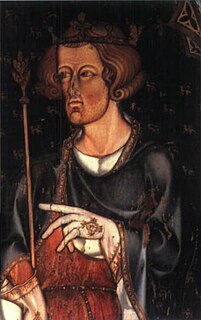 W
WThe conquest of Wales by Edward I, sometimes referred to as the Edwardian Conquest of Wales, to distinguish it from the earlier Norman conquest of Wales, took place between 1277 and 1283. It resulted in the defeat and annexation of the Principality of Wales, and the other last remaining independent Welsh principalities, by Edward I, King of England.
 W
WA coracle is a small, rounded, lightweight boat of the sort traditionally used in Wales, and also in parts of the West Country and in Ireland, particularly the River Boyne, and in Scotland, particularly the River Spey. The word is also used of similar boats found in India, Vietnam, Iraq and Tibet. The word "coracle" is an English spelling of the original Welsh cwrwgl, cognate with Irish and Scottish Gaelic currach, and is recorded in English text as early as the sixteenth century. Other historical English spellings include corougle, corracle, curricle and coricle.
 W
WCosmeston Medieval Village is a "living history" medieval village near Lavernock in the Vale of Glamorgan not far from Penarth and Cardiff in south Wales. Based upon remains discovered during a 1980s archaeological dig in the grounds of Cosmeston Lakes Country Park, it is a re-creation of 14th century peasant life in Wales in the Late Middle Ages.
 W
WThe Cymmer Colliery explosion occurred in the early morning of 15 July 1856 at the Old Pit mine of the Cymmer Colliery near Porth, Wales, operated by George Insole & Son. The underground gas explosion resulted in a "sacrifice of human life to an extent unparalleled in the history of coal mining of this country" in which 114 men and boys were killed. Thirty-five widows, ninety-two children, and other dependent relatives were left with no immediate means of support.
 W
WForden Gaer, Y Gaer, Caer Flos and Lavrobrinta are respective English, Welsh and possible Latin names for the Roman fort in the township of Thornbury, in the parish of Forden, in the old county of Montgomeryshire, which now forms part of Powys, Wales. The fort lies on the E bank of the Severn a short distance N of Montgomery, and covers an important crossing of the river close to the historic ford at Rhydywhyman. It is likely that this is the same fort as Lavrobrinta, which is mentioned in the Ravenna Cosmography. The fort lies on the Roman Road between Wroxeter and Caersws. The defences were originally of earth, subsequently revetted with a timber-laced rampart of clay. Some internal buildings may have been of stone. The fort was established ca. A.D. 75-80 and was not finally abandoned before the reign of Valentinian I. The finds are in the Powysland Museum, Welshpool.
 W
WThe Glyndŵr Rising, Welsh Revolt or Last War of Independence was an uprising of the Welsh between 1400 and 1415, led by Owain Glyndŵr, against the Kingdom of England. It was the last major manifestation of a Welsh independence movement before the incorporation of Wales into England by the Laws in Wales Acts 1535–1542.
 W
WSir Gruffydd ap Rhys was a Welsh nobleman. He was the son of Sir Rhys ap Thomas, the de facto ruler of most of south-west Wales who aided Henry Tudor in his victory on Bosworth Field in 1485 and Efa ferch Henry.
 W
WGwalia is an archaic Welsh name for Wales. It derives from the Medieval Latin Wallia, which in turn is a Latinisation of the English 'Wales'. Although never as widely used as Cymru, Gwalia was once popular as a poetic name for the country, akin to Albion.
 W
WFrederick James Hando MBE was a Welsh writer, artist and schoolteacher from Newport. He chronicled the history, character and folklore of Monmouthshire, which he also called Gwent, in a series of nearly 800 newspaper articles and several books published between the 1920s and 1960s.
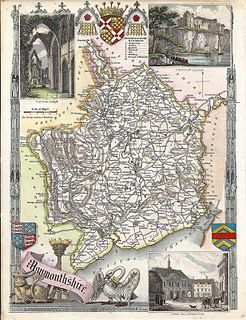 W
WA History of Monmouthshire from the Coming of the Normans into Wales down to the Present Time is a study of the county of Monmouthshire written by Sir Joseph Bradney and published by Mitchell, Hughes and Clarke of London between 1904 and 1932. The history comprised twelve volumes, based on six of the seven historic hundreds of Monmouthshire; Skenfrith, Abergavenny, Raglan, Trellech, Usk and Caldicot.
 W
WSir William Albert Jenkins was a Welsh coal exporter and ship owner and Liberal politician.
 W
WThe Landsker Line is a term used for the language border in Wales between the largely Welsh-speaking and largely English-speaking areas in Pembrokeshire and Carmarthenshire. The English-speaking areas, south of the Landsker line and known as Little England beyond Wales, are notable for having been English linguistically and culturally for many centuries despite being far from the England–Wales border.
 W
WLittle England beyond Wales is a name applied to an area of southern Pembrokeshire and southwestern Carmarthenshire in Wales, which has been English in language and culture for many centuries despite its remoteness from England. Its origins may lie in the Irish, Norse, Norman, Flemish and Saxon settlement that took place in this area more than in other areas of southwest Wales. Its northern boundary is known as the Landsker Line.
 W
WLloegyr is the medieval Welsh name for a region of Britain (Prydain). The exact borders are unknown, but some modern scholars hypothesize it ran south and east of a line extending from the Humber Estuary to the Severn Estuary, exclusive of Cornwall and Devon. The people of Lloegyr were called Lloegyrwys without distinction of ethnicity, the term applying to both Britons and Anglo-Saxons.
 W
WThe owner of the Gwrych Castle estate, and the High Sheriff of Denbighshire in 1828 was Lloyd Hesketh Bamford-Hesketh (1788–1861).
 W
WThe Lordship of Denbigh was a marcher lordship in North Wales created by Edward I in 1284 and granted to the Earl of Lincoln. It was centred on the borough of Denbigh and Denbigh Castle. The lordship was held successively by several of England's most prominent aristocratic families in the 14th and 15th centuries. Title to the lordship was disputed for much of the second half of the 14th century between two powerful noble families: the Mortimer Earls of March and the Montagu Earls of Salisbury. Eventually, the lordship returned to the crown when Edward, Duke of York, who had inherited the lordship through his grandmother, acceded to the throne in 1461 as Edward IV. In 1563, Elizabeth I revived the lordship and granted it to her favourite Lord Robert Dudley, later becoming the Earl of Leicester. Leicester mortgaged it to raise money and the lordship was finally returned to the crown when Elizabeth redeemed the mortgage in 1592/3.
 W
WIn English church history, a Nonconformist was a Protestant who did not "conform" to the governance and usages of the established Church of England. Broad use of the term was precipitated after the Restoration of the British monarchy in 1660, when the Act of Uniformity 1662 re-established the opponents of reform within the Church of England. By the late 19th century the term specifically included the Reformed Christians, plus the Baptists and Methodists. The English Dissenters such as the Puritans who violated the Act of Uniformity 1559—typically by practising radical, sometimes separatist, dissent—were retrospectively labelled as Nonconformists.
 W
WA.N. Palmer Centre for Local Studies and Archives holds the archives for the town of Wrexham. The archives are held at Regent Street, Wrexham, and run by Wrexham County Borough Council. The centre is named after local Wrexham historian Alfred Neobard Palmer. Wrexham's former police station on Regent Street, originally the barracks for the Royal Denbighshire Militia, also houses Wrexham County Borough Museum.
 W
WParc le Breos was a great medieval deer park in the south of the Gower Peninsula, about eight miles (13 km) west of Swansea, Wales, and about 1 1⁄4 miles (2.0 km) north of the Bristol Channel. The park was an enclosed, oval area of 6.7 miles (10.8 km) in circumference, covering about 2,000 acres (810 ha) and measuring 2 1⁄2 miles (east–west) by just over 1 3⁄4 miles. Parc le Breos was established in the 1220s CE by John de Braose, Marcher Lord of Gower and husband to Margaret Ferch Llywelyn, Llywelyn Fawr's daughter. Other than for deer husbandry, the park received an income from agistment, pannage, and from sales of wild honey, ferns and dead wood. There is evidence of rabbit warrens in the park. Whether the warrens were free or domestic is unknown.
 W
WPen y Bryn is a two-storey manor house, in Abergwyngregyn, Gwynedd, in north-west Wales, adjacent to the A55, five miles east of Bangor and eight miles west of Conwy. It is constructed mainly of broken stone, with roughly dressed quoins and a slate roof. The house is situated within Garth Celyn, a double bank and ditch, overlooking the Menai Strait to Anglesey. A smaller house was immediately adjacent in 1811 when Sir Richard Colt-Hoare recorded it; this was demolished by 1815. The present structure incorporates a four-storey stone tower. The present roof timbers were dated by dendrochronology to 1624, when the house was refurbished. There is evidence of long use with multiple rebuildings before 1624, but there is disagreement on the duration and nature of its mediaeval use.
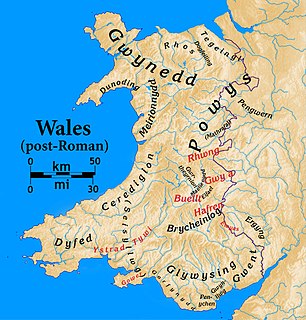 W
WPengwern was a Brythonic settlement of sub-Roman Britain situated in what is now the English county of Shropshire, adjoining the modern Welsh border. It is generally regarded as being the early seat of the kings of Powys before its establishment at Mathrafal, further west, but the theory that it may have been an early kingdom has also been postulated. Its precise location is uncertain.
 W
WPenhow Castle, Penhow, Newport dates from the early 12th century. Extended and reconstructed in almost every century since, it has been claimed to be the oldest continuously-inhabited castle in Wales. The castle is a Grade II* listed building.
 W
WPrydain is the modern Welsh name for Great Britain.
 W
WThe Red Bandits of Mawddwy were a band of red-haired robbers, highwaymen or footpads from the area of Mawddwy in Mid Wales in the 16th century, who became famous in folk literature.
 W
WRhug is a township in the parish of Corwen, Denbighshire, Wales, formerly in the old cantref of Edeirnion and later a part of Merionethshire, two miles from Corwen and ten miles north east of Bala. It includes the hamlet of Bonwen. It is situated near the River Dee, under Berwyn range. About 1150, it was ruled by the Maer Du or "Black Mayor of Rhug" and later became part of the lands of the barons of Edeirnion who ruled from Gwerclas Castle.
 W
WRhwng Gwy a Hafren was a region of medieval Wales, located in the Welsh Marches between Powys to the north and Brycheiniog to the south. It was bounded by the rivers Wye and Severn. It covered about the same territory as Radnorshire, now part of the county of Powys. The region first came into its own in the 9th or 10th centuries, when it was ruled by leaders who operated independently of the surrounding kingdoms. After the Norman invasion, it comprised the central part of the Welsh Marches and was the site of frequent struggles between Welsh and Norman forces.
 W
WRichard Owens was a Welsh architect, working mostly on urban housing in Liverpool, England and on the construction of chapels in Wales.
 W
WThe Chronicles and Memorials of Great Britain and Ireland during the Middle Ages, widely known as the Rolls Series, is a major collection of British and Irish historical materials and primary sources published as 99 works in 253 volumes between 1858 and 1911. Almost all the great medieval English chronicles were included: most existing editions, published by scholars of the 17th and 18th centuries, were considered to be unsatisfactory. The scope was also extended to include legendary, folklore and hagiographical materials, and archival records and legal tracts. The series was government-funded, and takes its unofficial name from the fact that its volumes were published "by the authority of Her Majesty's Treasury, under the direction of the Master of the Rolls", who was the official custodian of the records of the Court of Chancery and other courts, and nominal head of the Public Record Office.
 W
WDr. David D. Rowlands, M.D., F.R.S., F.A.S. (1778–1846) was a Welsh naval surgeon, who became the Inspector of H.M. Hospital and Fleets for the Royal Navy. He had the distinction of being the Surgeon for the Royal Navy at Halifax when he treated the wounded of HMS Shannon, including Captain Philip Broke, after the renown Capture of USS Chesapeake during the War of 1812. He was a Fellow of the Royal Society and a Fellow of the Antiquarian Society. He also supported the Governesses' Benevolent Institution in London (1844).
 W
WSegontium is a Roman fort on the outskirts of Caernarfon in Gwynedd, North Wales. The fort, which survived until the end of the Roman occupation of Britain, was garrisoned by Roman auxiliaries from present-day Belgium and Germany. It was the most important military base and administrative centre in this part of Britain.
 W
WStrata Florida Abbey is a former Cistercian abbey situated just outside Pontrhydfendigaid, near Tregaron in the county of Ceredigion, Wales. The abbey was founded in 1164. Strata Florida is a Latinisation of the Welsh Ystrad Fflur; 'Valley of Flowers'; the Welsh word ystrad is synonymous with strath and dale, while fflur ("flower") is also the name of the nearby river. After the region around St Davids was firmly occupied by the Norman Marcher lordship of Pembroke by the early 12th century, with St Davids firmly under Norman influence thereafter, the princely Dinefwr family of Deheubarth transferred their patronage to Strata Florida, and interred many of their family members there.
 W
WThe Sunday Closing (Wales) Act 1881 was an Act of the Parliament of the United Kingdom. It was one of the Licensing Acts 1828 to 1886. It required the closure of all public houses in Wales on Sundays. The Act had considerable political importance as a formal acknowledgement of the separate character of Wales, setting a precedent for future legislation and decisions. It was repealed in 1961.
 W
WWales in the Middle Ages covers the history of the country that is now called Wales, from the departure of the Romans in the early fifth century, until the annexation of Wales into the Kingdom of England in the early sixteenth century.
 W
W*Walhaz is a reconstructed Proto-Germanic word meaning "Roman", "Romance-speaker", or "Celtic-speaker". The term was used by the ancient Germanic peoples to describe inhabitants of the former Western Roman Empire, who were largely romanised and spoke Latin or Celtic languages. The adjectival form is attested in Old Norse valskr, meaning "French"; Old High German walhisk, meaning "Romance"; New High German welsch, used in Switzerland and South Tyrol for Romance speakers; Dutch Waals "Walloon"; Old English welisċ, wælisċ, wilisċ, meaning "Romano-British". The forms of these words imply that they are descended from a Proto-Germanic form *walhiska-. It is attested in the Roman Iron Age from an inscription on one of the Tjurkö bracteates, where walhakurne "Roman/Gallic grain" is apparently a kenning for "gold".
 W
WThe Welsh coal strike of 1898 was an industrial dispute involving the colliers of South Wales and Monmouthshire. The strike began as an attempt by the colliers to remove the sliding scale, which determined their wage based on the price of coal. The strike quickly turned into a disastrous lockout which would last for six months and result in a failure for the colliers as the sliding scale stayed in place. The strike is seen as an important landmark in Welsh history as it saw the true adoption of trade unionism in the southern coalfield which had been slow to take hold before then. The South Wales Miners' Federation was the largest trade union to have originated from this dispute.
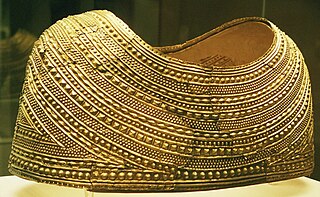 W
WWelsh gold is gold that occurs naturally in two distinct areas of Wales and highly prized because of its origin and scarcity. One area it is found in is North Wales in a band stretching from Barmouth, past Dolgellau and up towards Snowdonia. This was mined at several mines, the largest of which were the Gwynfynydd Gold Mine, near Ganllwyd, and the Clogau Gold Mine near Bontddu. In South Wales, it is found in a small area in the valley of the River Cothi at Dolaucothi where it is known to have been mined by the Romans.
 W
WThis is an index of Welsh peers and baronets whose primary peerage, life peerage, and baronetcy titles include a Welsh place-name origin or its territorial qualification is within the historic counties of Wales.
 W
WWelsh settlement in the Americas was the result of several individual initiatives to found distinctively Welsh settlements in the New World. It can be seen as part of the more general British colonization of the Americas.
 W
WFixed surnames were adopted in Wales from the 15th century onwards. Until then, the Welsh had a patronymic naming system.